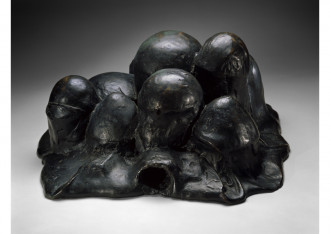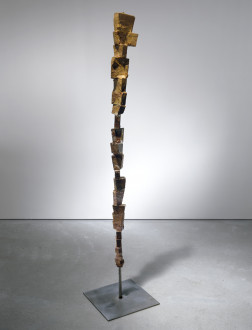Louise Bourgeois
Long-term view, Dia Beacon
Overview
“Every day,” Louise Bourgeois said, “you have to abandon your past or accept it, and then, if you cannot accept it, you become a sculptor.” For her, making art entails trying to translate experience into form—an operation that she compares with exorcism. In Bourgeois’s works on view in these galleries, organic formations fuse with the inorganic materiality of the media in which they are rendered, be it marble, wood, or bronze. The artist’s repertoire of materials spans traditional media and new textures, such as latex and synthetic resin. In her work, representation often entails the creation of a surrogate for the body and its suffering organs.
Mnemonic, symbolic, evocative, and restrained—these strong, if contradictory, qualities are typical of Louise Bourgeois’s sculpture. “Every day,” she declared, “you have to abandon your past or accept it, and then, if you cannot accept it, you become a sculptor.” For her, the art-making process was a search for the forms that translate experiences—an operation that she compared with exorcism. The sculptor is her own healer, the work a sort of proxy that reveals the forms of trauma: elusive, almost abstract, but also descriptive. In Bourgeois’s figures, one can recognize limbs, organs, and organic formations that fuse with the inorganic materiality of the medium, be it marble, resin, wood, or bronze. In fact, the choice of a specific material was something completely intuitive for the artist: “The medium is always a matter of makeshift solutions. That is, you try everything, you use every material around, and usually they repulse you. Finally, you get one that will work for you. And it is usually the softer ones—lead, plaster, malleable things. That is to say that you start with the harder thing and life teaches you that you had better buckle down, be contented with softer things, softer ways.”
As illustrated in this presentation in Dia:Beacon’s attic—a place akin to the intimate mood of Bourgeois’s art—the artist’s repertoire of materials was as connected to traditional media such as bronze or marble as it was open to new textures, such as those of latex and synthetic resin. Latex, in its similarity to human skin, conveys a feeling intrinsic to Bourgeois’s aesthetic, where representation often entails the creation of a surrogate for the body and its suffering organs. Yet her images of the body point not at its appearance, but the way it is perceived from within. Bourgeois’s body is a psychological, internalized one—the body as it is experienced by the sufferer—and the accumulations of members and membranes are symbolically powerful because they are imaginary.
Interconnections among different moments in time infuse Bourgeois’s approach to art making as well as the objects she generates: over a career of more than seventy years, she repeatedly returned to particular motifs, constantly probing, expanding, and reformulating their forms. Certain works suggest an intricate relationship between architecture—the living space where feelings are transferred— and the human body—understood as the (haunted) house of the self. “Space does not exist,” Bourgeois claimed. “It is just a metaphor for the structure of our existence.” This idea is already present in her first mature works, made in the 1940s, when she began to explore a concept she called the femme-maison, or “woman-house.” In the 1960s, this concept bifurcated into various related series—Soft Landscapes, Lairs—expressive of both haven and prison, refuge and trap.
Some sculptures evoke human shelters and those made by other creatures—cocoons, carapaces, shell-like vessels—at the same time that they are rife with allusions to the body. In later series, notably exemplified here by Crouching Spider (2003), the organic aspect is emphasized, and the predominant feeling is exacerbated: cold, threatening, and unforgiving. A frequent subject in her later work, the spider is a weaver. Tellingly, as a child, Bourgeois worked with woven fabrics, helping her parents in the family business of tapestry repair. This dichotomy between protection and threat expresses Bourgeois’s ambivalent idea of maternity. But, though all her works are resolutely autobiographical, the artist refused to assign rigid meanings to her pieces. They are expressions of desire and trauma, simultaneously physical and invisible, bodily and amorphous.

- Fée couturière, 1963
Painted bronze; edition 6/6
Collection Louise Bourgeois Trust - The Quartered One, 1964–65
Bronze with patina; edition 3/6
Collection The Easton Foundation - Lair, 1962
Plaster
Collection The Easton Foundation - Amoeba, 1963–65
Painted bronze
Collection The Easton Foundation - Hanging Janus with Jacket, 1968
Bronze; edition 1/6
Collection The Easton Foundation - Janus, 1968
Bronze; edition 1/6
Collection The Easton Foundation - Janus in Leather Jacket, 1968
Bronze; edition 2/6
Collection Louise Bourgeois Trust - Inner Ear, 1962
Bronze with nitrate patina; edition 4/6
Collection Louise Bourgeois Trust - Avenza Revisited II, 1968–69
Bronze with nitrate patina; edition 1/6
Collection Louise Bourgeois Trust - Memling Dawn, 1951
Bronze and stainless steel
AP 1/1, edition of 6
Collection The Easton Foundation - Untitled, 1954
Painted cork and stainless steel
Collection The Easton Foundation - Untitled, 1954–62
Painted wood, latex, and stainless steel
Collection The Easton Foundation - Untitled, 1954
Painted wood and stainless steel
Collection The Easton Foundation - Maisons Fragiles, 1978
Steel
Courtesy Cheim & Read and Hauser & Wirth - Crouching Spider, 2003
Bronze, polished patina, and stainless steel;
edition 2/6
Collection Louise Bourgeois Trust
tabletop:
- Labyrinthine Tower, 1962
Bronze; edition 2/6
Collection Louise Bourgeois Trust - The Open Hand (variant), 1966
Bronze; edition 1/2
Collection Louise Bourgeois Trust - End of Softness, 1967
Bronze with patina; edition 3/6
Collection The Easton Foundation - La Patte, 1965
Bronze with nitrate patina; edition 3/6
Collection Louise Bourgeois Trust - The Fingers, 1968
Bronze; AP
Collection The Easton Foundation - Etretat, 1960
Bronze with nitrate patina; edition 1/6
Collection Louise Bourgeois Trust - Lair, 1962
Plaster; exhibition copy
Collection The Easton Foundation - Three Roses, 1968
Bronze; edition 1/6
Collection Louise Bourgeois Trust - Germinal, 1967
Bronze; edition 2/6
Collection The Easton Foundation - The Goodies, 1961
Plaster, wood, wire, and glue
Collection The Easton Foundation - Unconscious Landscape, 1967–68
Bronze with patina; edition 1/6
Collection The Easton Foundation - Clutching, 1962
Bronze with patina
AP 1/1, edition of 6
Collection The Easton Foundation
Louise Bourgeois was born in 1911 in Paris. She entered the Sorbonne to study mathematics in 1932 but turned to art the next year. She enrolled at several art schools, including the École des Beaux-Arts in Paris, in addition to apprenticing in artists’ studios in Montparnasse and Montmartre. She then immigrated to New York in 1938, and continued her studies at the Art Students League. Her first one-person exhibition was held at the Bertha Schaefer Gallery, New York, in 1945, and her sculpture was first shown in 1949 at the Peridot Gallery, New York. In 1982 the Museum of Modern Art, New York, organized a retrospective, which traveled to various American venues. Her work has since been shown internationally, including in Documenta 9, Kassel, Germany (1992), and the São Paulo Bienal (1996). Bourgeois’s first European retrospective was organized in 1989, traveling from the Frankfurter Kunstverein to the Städtische Galerie im Lenbachhaus, Munich, and the Fundació Antoni Tàpies, Barcelona, among other venues. Bourgeois represented the United States at the Venice Biennale in 1993. Tate Modern, London, organized a major traveling retrospective of her work in 2007. Bourgeois died in New York City in 2010.
Related Events

Dia Talks
Julia Phillips on Louise Bourgeois
Wednesday, May 1, 2024, 6:30 pm, Dia Chelsea
Artist
Louise Bourgeois
Louise Bourgeois was born in Paris in 1911. She died in New York City in 2010.
Selected Works on View

Louise Bourgeois
Hanging Janus with Jacket, 1968
Go to Hanging Janus with Jacket page
Louise Bourgeois
Janus, 1968
Go to Janus page
Louise Bourgeois
Janus in Leather Jacket, 1968
Go to Janus in Leather Jacket page
Louise Bourgeois
Fée couturière, 1963
Go to Fée couturière page
Louise Bourgeois
Labyrinthine Tower, 1962
Go to Labyrinthine Tower page
Louise Bourgeois
Lair, 1962
Go to Lair page
Louise Bourgeois
The Fingers, 1968
Go to The Fingers page
Louise Bourgeois
End of Softness, 1967
Go to End of Softness page
Louise Bourgeois
Germinal, 1967
Go to Germinal page
Louise Bourgeois
Unconscious Landscape, 1967–68
Go to Unconscious Landscape page
Louise Bourgeois
Three Roses, 1968
Go to Three Roses page
Louise Bourgeois
Etretat, 1960
Go to Etretat page
Louise Bourgeois
Lair, 1962
Go to Lair page
Louise Bourgeois
Avenza Revisited II, 1968–69
Go to Avenza Revisited II page
Louise Bourgeois
The Open Hand (variant), 1966
Go to The Open Hand (variant) page
Louise Bourgeois
Clutching, 1962
Go to Clutching page
Louise Bourgeois
The Goodies, 1961
Go to The Goodies page
Louise Bourgeois
Crouching Spider, 2003
Go to Crouching Spider page
Louise Bourgeois
La Patte, 1965
Go to La Patte page
Louise Bourgeois
Memling Dawn, 1951
Go to Memling Dawn page
Louise Bourgeois
Untitled, 1954
Go to Untitled page
Louise Bourgeois
Untitled, 1954 c.
Go to Untitled page
Louise Bourgeois
Untitled, 1954
Go to Untitled page
Louise Bourgeois
The Quartered One, 1964–65
Go to The Quartered One page
Louise Bourgeois
Maisons Fragiles, 1978
Go to Maisons Fragiles page
Louise Bourgeois
Inner Ear, 1962
Go to Inner Ear page
Louise Bourgeois
Amoeba, 1963–65
Go to Amoeba pageExplore
Elaine Reichek on Louise Bourgeois
Move to Elaine Reichek on Louise Bourgeois pagePatty Chang on Louise Bourgeois
Move to Patty Chang on Louise Bourgeois page
Elaine Reichek on Louise Bourgeois
Move to Elaine Reichek on Louise Bourgeois page
